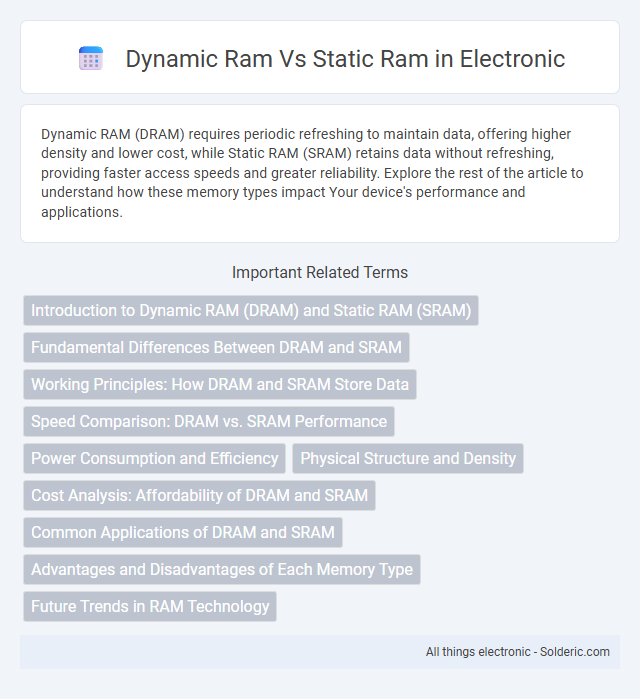Dynamic RAM (DRAM) requires periodic refreshing to maintain data, offering higher density and lower cost, while Static RAM (SRAM) retains data without refreshing, providing faster access speeds and greater reliability. Explore the rest of the article to understand how these memory types impact Your device's performance and applications.
Comparison Table
| Feature | Dynamic RAM (DRAM) | Static RAM (SRAM) |
|---|---|---|
| Storage Technology | Capacitor-based memory cells | Flip-flop based memory cells |
| Data Retention | Requires periodic refresh | Holds data as long as power is supplied |
| Speed | Slower access time (typically 50-70 ns) | Faster access time (typically 10 ns or less) |
| Density | Higher density, more bits per chip | Lower density, fewer bits per chip |
| Power Consumption | Higher due to refresh cycles | Lower during steady operation |
| Cost | Lower cost per bit | Higher cost per bit |
| Typical Use | Main system memory (e.g., RAM in PCs) | Cache memory and small fast buffers |
Introduction to Dynamic RAM (DRAM) and Static RAM (SRAM)
Dynamic RAM (DRAM) stores data using capacitors that require constant refreshing, making it slower but more cost-effective for larger memory capacities. Static RAM (SRAM) relies on flip-flop circuits to retain data without needing refresh cycles, resulting in faster access times and higher reliability at a greater expense. Your choice between DRAM and SRAM will depend on the balance you need between speed, capacity, and cost for your computing application.
Fundamental Differences Between DRAM and SRAM
Dynamic RAM (DRAM) stores data using capacitors that require periodic refreshing to retain information, making it volatile with slower access times but higher density and lower cost per bit. Static RAM (SRAM) uses bistable latching circuitry to hold data without the need for refreshing, resulting in faster access speeds, greater power consumption, and more complex design that provides lower density and higher cost per bit. The fundamental difference lies in DRAM's capacitor-based storage mechanism versus SRAM's flip-flop-based architecture, influencing their respective use cases in memory hierarchy and performance characteristics.
Working Principles: How DRAM and SRAM Store Data
Dynamic RAM (DRAM) stores data using capacitors that need constant refreshing due to charge leakage, making it slower but highly dense and cost-effective for main memory. Static RAM (SRAM) uses bistable flip-flop circuits to hold data without refreshing, offering faster access speeds and greater stability at the expense of higher power consumption and lower density. Your choice between DRAM and SRAM depends on the need for speed versus memory capacity and power efficiency.
Speed Comparison: DRAM vs. SRAM Performance
SRAM offers faster access times compared to DRAM due to its simpler internal architecture, which eliminates the need for constant refreshing and allows quicker data retrieval. DRAM, while slower, provides higher density and cost-effective memory suitable for large-scale storage in your computing devices. Choosing SRAM enhances speed-critical applications, whereas DRAM balances performance with capacity for general-purpose use.
Power Consumption and Efficiency
Dynamic RAM (DRAM) consumes more power than Static RAM (SRAM) due to its need for constant refreshing to maintain data, which increases energy usage and reduces efficiency. SRAM, with its bistable latching circuitry, offers lower power consumption and higher efficiency, making it ideal for cache memory in processors where speed and power efficiency are critical. Your choice between DRAM and SRAM should consider the power consumption requirements and overall efficiency needs of your computing system.
Physical Structure and Density
Dynamic RAM (DRAM) consists of a single transistor and capacitor per memory cell, allowing high density and compact physical structure ideal for larger memory arrays. Static RAM (SRAM) uses multiple transistors (typically six) per cell, resulting in a bulkier design with lower density but faster access speeds. DRAM's simpler cell design enables higher memory capacity per chip compared to SRAM's complex, space-intensive layout.
Cost Analysis: Affordability of DRAM and SRAM
Dynamic RAM (DRAM) offers greater affordability compared to Static RAM (SRAM) due to its simpler cell design and higher density, allowing manufacturers to produce more memory per chip at lower costs. SRAM, with its faster access speeds and more complex circuitry, incurs higher production expenses, making it significantly pricier per megabyte. Your choice between DRAM and SRAM should consider this cost difference against performance needs, as DRAM is typically preferred for cost-sensitive, high-capacity applications.
Common Applications of DRAM and SRAM
DRAM is predominantly used in main system memory for computers and mobile devices due to its high density and cost-effectiveness. SRAM is commonly found in cache memory within CPUs and embedded systems, where speed and low latency are critical. Both memory types serve essential roles, with DRAM optimizing large memory capacity and SRAM enhancing rapid data access.
Advantages and Disadvantages of Each Memory Type
Dynamic RAM (DRAM) offers higher density and lower cost per bit, making it ideal for main memory in computers, but it requires periodic refreshing due to charge leakage, resulting in slower access times and higher power consumption. Static RAM (SRAM) provides faster access speeds and consumes less power during operation since it does not need refreshing, which makes it suitable for cache memory; however, it is more expensive and has lower density compared to DRAM. The trade-off between DRAM's cost-efficiency and SRAM's performance and power efficiency determines their specific applications in computing devices.
Future Trends in RAM Technology
Emerging RAM technologies increasingly prioritize speed, energy efficiency, and density, with static RAM (SRAM) likely evolving through innovations like embedded SRAM (eSRAM) for faster cache memory in processors. Dynamic RAM (DRAM) advancements focus on increasing capacity and reducing power consumption using next-generation designs such as DDR5 and LPDDR5 for mobile and server applications. Future trends also explore novel memory types like MRAM and ReRAM that blend the benefits of DRAM's density and SRAM's speed, aiming to revolutionize memory hierarchies in computing systems.
dynamic ram vs static ram Infographic

 solderic.com
solderic.com